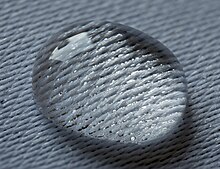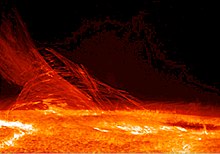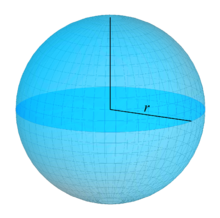


A surface, as the term is most generally used, is the outermost or uppermost layer of a physical object or space. It is the portion or region of the object that can first be perceived by an observer using the senses of sight and touch, and is the portion with which other materials first interact. The surface of an object is more than "a mere geometric solid", but is "filled with, spread over by, or suffused with perceivable qualities such as color and warmth".
The concept of surface has been abstracted and formalized in mathematics, specifically in geometry. Depending on the properties on which the emphasis is given, there are several non equivalent such formalizations, that are all called surface, sometimes with some qualifier, such as algebraic surface, smooth surface or fractal surface.
The concept of surface and its mathematical abstraction are both widely used in physics, engineering, computer graphics, and many other disciplines, primarily in representing the surfaces of physical objects. For example, in analyzing the aerodynamic properties of an airplane, the central consideration is the flow of air along its surface. The concept also raises certain philosophical questions—for example, how thick is the layer of atoms or molecules that can be considered part of the surface of an object (i.e., where does the "surface" end and the "interior" begin), and do objects really have a surface at all if, at the subatomic level, they never actually come in contact with other objects.
Perception of surfaces
The surface of an object is the part of the object that is primarily perceived. Humans equate seeing the surface of an object with seeing an object. For example, in looking at an automobile, it is normally not possible to see the engine, electronics, and other internal structures, but the object is still recognized as an automobile because the surface identifies it as one. Conceptually, the "surface" of an object can be defined as the topmost layer of atoms. Many objects and organisms have a surface that is in some way distinct from their interior. For example, the peel of an apple has very different qualities from the interior of the apple, and the exterior surface of a radio may have very different components from the interior. Peeling the apple constitutes removal of the surface, ultimately leaving a different surface with a different texture and appearance, identifiable as a peeled apple. Removing the exterior surface of an electronic device may render its purpose unrecognizable. By contrast, removing the outermost layer of a rock or the topmost layer of liquid contained in a glass would leave a substance or material with the same composition, only slightly reduced in volume.
In mathematics
This section is an excerpt from Surface (mathematics).
In mathematics, a surface is a mathematical model of the common concept of a surface. It is a generalization of a plane, but, unlike a plane, it may be curved; this is analogous to a curve generalizing a straight line.
There are several more precise definitions, depending on the context and the mathematical tools that are used for the study. The simplest mathematical surfaces are planes and spheres in the Euclidean 3-space. The exact definition of a surface may depend on the context. Typically, in algebraic geometry, a surface may cross itself (and may have other singularities), while, in topology and differential geometry, it may not.
A surface is a topological space of dimension two; this means that a moving point on a surface may move in two directions (it has two degrees of freedom). In other words, around almost every point, there is a coordinate patch on which a two-dimensional coordinate system is defined. For example, the surface of the Earth resembles (ideally) a sphere, and latitude and longitude provide two-dimensional coordinates on it (except at the poles and along the 180th meridian).In the physical sciences
See also: Euclidean planes in three-dimensional space § Occurrence in natureThe concept of a surface in the physical sciences encompasses the structures and dynamics of and occurring at surfaces. The field underlies many practical disciplines such as semiconductor physics and applied nanotechnology but is also of fundamental interest.
Synchrotron x-ray and neutron scattering measurements are used to provide experimental data on the structure and motion of molecular adsorbates adsorbed on surfaces. The aim of such methods is to provide the data needed to benchmark the latest developments in the modelling of surface systems, their electronic and physical structures and the energetics and friction associated with surface motion.
Current projects focus on the surface adsorption of polyaromatic hydrocarbons (PAHs), a class of molecules key to the refinement of the modelling of dispersive forces through approaches such as density functional theory, and build on our complementary work applying helium atom scattering and scanning tunnelling microscopy to small molecules with aromatic functionality.
Many surfaces considered in physics and chemistry (physical sciences in general) are interfaces. For example, a surface may be the idealized limit between two fluids, liquid and gas (the surface of the sea in air) or the idealized boundary of a solid (the surface of a ball). In fluid dynamics, the shape of a free surface may be defined by surface tension. However, they are surfaces only at macroscopic scale. At microscopic scale, they may have some thickness. At atomic scale, they do not look at all as a surface, because of holes formed by spaces between atoms or molecules.
Other surfaces considered in physics are wavefronts. One of these, discovered by Fresnel, is called wave surface by mathematicians.
The surface of the reflector of a telescope is a paraboloid of revolution.
Other occurrences:
- Soap bubbles, which are physical examples of minimal surfaces
- Equipotential surface in, e.g., gravity fields
- Earth's surface
- Surface science, the study of physical and chemical phenomena that occur at the interface of two phases
- Surface metrology
- Surface wave, a mechanical wave
- Atmospheric boundaries (tropopause, edge of space, plasmapause, etc.)
In computer graphics
Main article: Computer representation of surfaces| This section needs expansion. You can help by adding to it. (April 2016) |
One of the main challenges in computer graphics is creating realistic simulations of surfaces. In technical applications of 3D computer graphics (CAx) such as computer-aided design and computer-aided manufacturing, surfaces are one way of representing objects. The other ways are wireframe (lines and curves) and solids. Point clouds are also sometimes used as temporary ways to represent an object, with the goal of using the points to create one or more of the three permanent representations.
One technique used for enhancing surface realism in computer graphics is the use of physically-based rendering (PBR) algorithms which simulate the interaction of light with surfaces based on their physical properties, such as reflectance, roughness, and transparency. By incorporating mathematical models and algorithms, PBR can generate highly realistic renderings that resemble the behavior of real-world materials. PBR has found practical applications beyond entertainment, extending its impact to architectural design, product prototyping, and scientific simulations.
References
- Sparke, Penny & Fisher, Fiona (2016). The Routledge Companion to Design Studies. New York: Routledge. p. 124. ISBN 9781317203285. OCLC 952155029.
- ^ Sorensen, Roy (2011). Seeing Dark Things: The Philosophy of Shadows. Oxford: Oxford University Press. p. 45. ISBN 9780199797134. OCLC 955163137.
- Butchvarov, Panayot (1970). The Concept of Knowledge. Evanston: Northwestern University Press. p. 249. ISBN 9780810103191. OCLC 925168650.
- Stroll, Avrum (1988). Surfaces. Minneapolis: University of Minnesota Press. p. 205. ISBN 9780816616947. OCLC 925290683.
- Plesha, Michael; Gray, Gary & Costanzo, Francesco (2012). Engineering Mechanics: Statics and Dynamics (2nd ed.). New York: McGraw-Hill Higher Education. p. 8. ISBN 9780073380315. OCLC 801035627.
- Butchvarov (1970), p. 253.
- Stroll (1988), p. 54.
- Stroll (1988), p. 81.
- Gibson, James J. (1950). "The Perception of Visual Surfaces". The American Journal of Psychology. 63 (3): 367–384. doi:10.2307/1418003. ISSN 0002-9556. JSTOR 1418003.
- "Surface Physics". School of Physical Sciences. 2019-03-28. Retrieved 2024-09-23.
- "Surface | Definition & Facts | Britannica". www.britannica.com. Retrieved 2024-09-23.